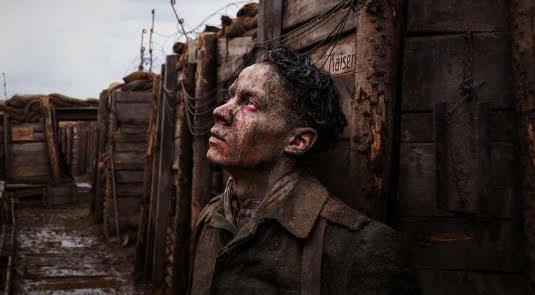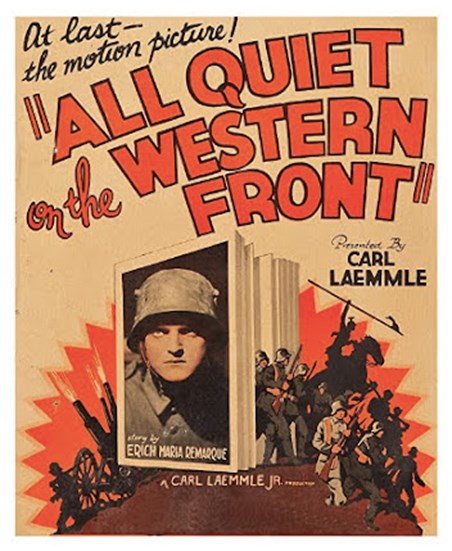Film Review : All Quiet on the Western Front reviewed by Major General David T. Zabecki, U.S. Army (Ret’d)
- Home
- World War I Book Reviews
- Film Review : All Quiet on the Western Front reviewed by Major General David T. Zabecki, U.S. Army (Ret’d)

[This article first featured in edition No.123 of Bulletin (page 48). Members received this, our in-house magazine three times a year and Stand To! our journal, four times a year].

The new German remake of All Quiet on the Western Front is an excellent movie-right up until the final half hour. Then it goes off the rails. The period work is spot-on. The uniforms and the equipment details are correct. The film accurately depicts the stark and brutal realities of life and death in the trenches. One of the pivotal and most gut-wrenching scenes is where Landser Paul Bäumer, lying in a shell hole, kills the Poilu who had been a printer in civilian life. It is a faithful re-creation of the horror of the book. But...
Approaching the end of the movie we see a series of scenes depicting the German surrender negotiations of 8-11 November 1918 in the railway car at Compiègne. There is nothing like this in the book. In the first place, the original story is a Landser’s-eye view of the war. There isn’t a single general officer in the story. That whole sequence was put in there to set up the end of the film, which departs completely from the book, and departs even further from history. The minute I saw the surrender negotiation scenes I was afraid of what was coming.
The film would have you believe that just hours before the Armistice went into effect at 1100 hours on 11 November, a German general named Friedrich ordered a last minute, massive suicide attack to “save the honour of the German Army.” An entirely invented character, “General Friedrich” is clearly supposed to be General Erich Ludendorff. But Ludendorff wasn’t even there on 11 November. The Kaiser fired him on 26 October and Ludendorff then went into hiding in Sweden. Ludendorff’s successor, General Wilhelm Gröner, would have never done anything so stupid.
The German Army on the morning of 11 November was absolutely incapable of large attacks anywhere. The bulk of the German Army was retreating eastward, trying to get behind the line of the Meuse River. If the German soldiers had been ordered to attack en masse during the last hours before 1100, they most likely would have refused. There had already been widespread mutinies back in Germany and morale was rock bottom in the front lines. They knew the war was all but over.
It was the Allies who kept attacking right up to 1100 hours, especially the Americans. Pershing ordered the AEF to keep attacking hard right up until 1059 hours. Officially more than 10,000 Allied soldiers were killed, wounded or went missing on 11 November 1918, all for absolutely no additional military or political gain. The Americans alone racked-up some 3,000 casualties in the last eleven hours of the war. Keep in mind that the AEF accounted for less than 20 percent of the total Allied troops in the field.
Another problem is how that last large-scale attack was portrayed as a mass, linear frontal assault, with the NCOs and junior officers shouting for the troops to maintain their alignments. That may have been how all sides conducted attacks during the first years of the war; but by the middle of 1917 things had changed drastically. The Germans in particular evolved innovative and fluid infiltration tactics—sometimes called “Stormtroop Tactics”—that emphasised by-passing and isolating points of strong enemy resistance to strike at more vulnerable and vital targets deep in the defender’s rear. The final attack of the film was about as far as possible from the standard German offensive tactics of 1918.

Paul Bäumer, of course, is killed in this current film’s last great suicide attack. The book, however, does not give specific details on how Paul died. All it says is “He fell in October 1918, on a day that was so quiet and still on the whole front that the army report confined itself to the single sentence: “Im Westen Nicht Neues.”
The end of the 1930 Oscar-winning movie shows Paul sitting by himself in a quiet trench line, He sees a butterfly on the parapet and reaches up for it, and gets a bullet in the head. The scene is true to the spirit of the book, and it has far more real irony than the bogus and completely improbable scenario that this new movie portrays.
It is difficult to understand why the German producers of this new film version altered both the original story and History itself to make the Germans look like suicidal automatons at the end.
Review by Major General David T. Zabecki, U.S. Army (Ret’d)





